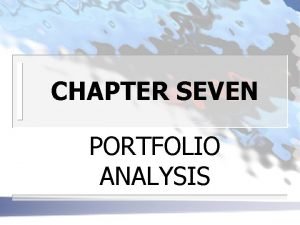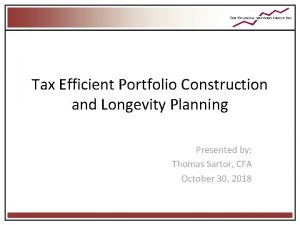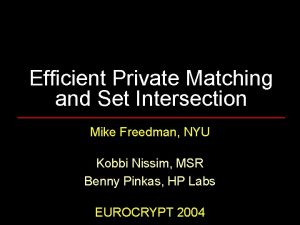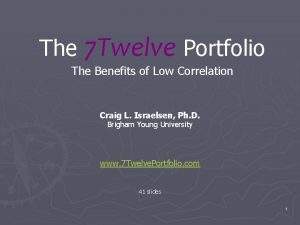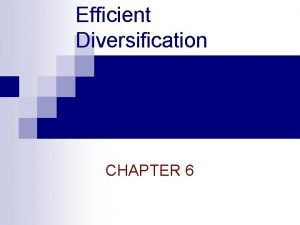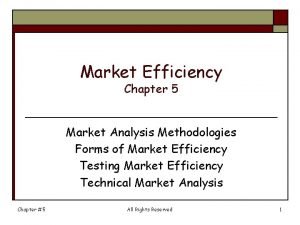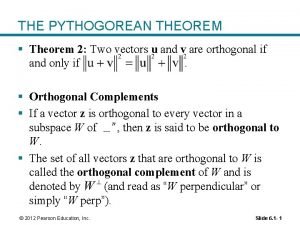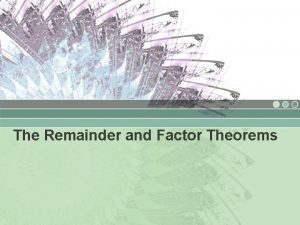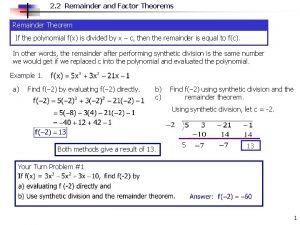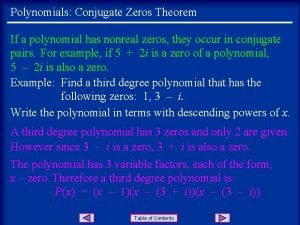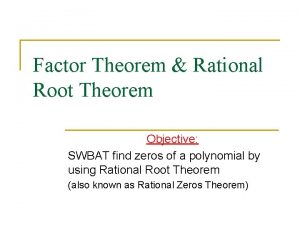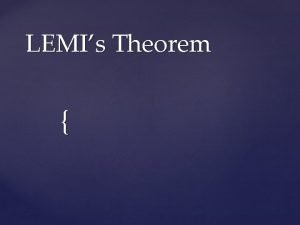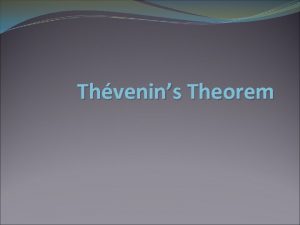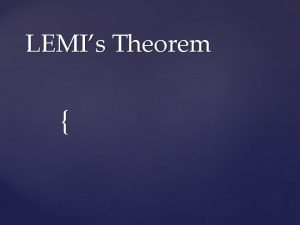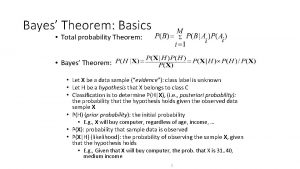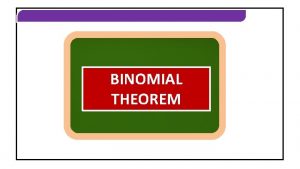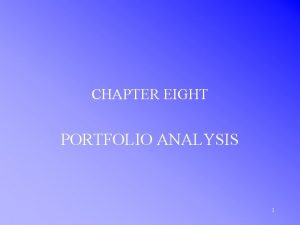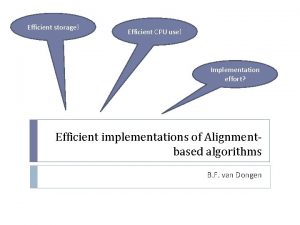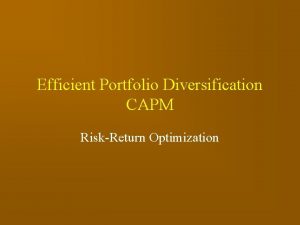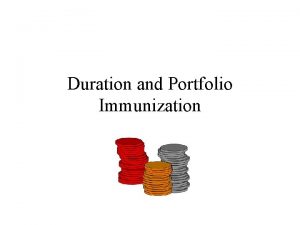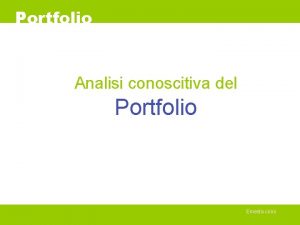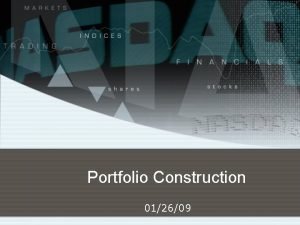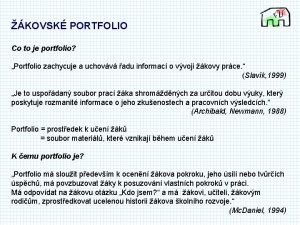CHAPTER SEVEN PORTFOLIO ANALYSIS THE EFFICIENT SET THEOREM




























- Slides: 28

CHAPTER SEVEN PORTFOLIO ANALYSIS

THE EFFICIENT SET THEOREM n THEOREM • An investor will choose his optimal portfolio from the set of portfolios that offer 3 maximum expected returns for varying levels of risk, and 3 minimum risk for varying levels of returns

THE EFFICIENT SET THEOREM n THE FEASIBLE SET • DEFINITION: represents all portfolios that could be formed from a group of N securities

THE EFFICIENT SET THEOREM THE FEASIBLE SET r. P 0 s. P

THE EFFICIENT SET THEOREM n EFFICIENT SET THEOREM APPLIED TO THE FEASIBLE SET • Apply the efficient set theorem to the feasible set 3 the set of portfolios that meet first conditions of efficient set theorem must be identified 3 consider 2 nd condition set offering minimum risk for varying levels of expected return lies on the “western” boundary 3 remember both conditions: “northwest” set meets the requirements

THE EFFICIENT SET THEOREM n THE EFFICIENT SET • where the investor plots indifference curves and chooses the one that is furthest “northwest” • the point of tangency at point E

THE EFFICIENT SET THEOREM THE OPTIMAL PORTFOLIO r. P E 0 s. P

CONCAVITY OF THE EFFICIENT SET n WHY IS THE EFFICIENT SET CONCAVE? • BOUNDS ON THE LOCATION OF PORFOLIOS • EXAMPLE: 3 Consider two securities – – Ark Shipping Company • E(r) = 5% s = 20% Gold Jewelry Company • E(r) = 15% s = 40%

CONCAVITY OF THE EFFICIENT SET r. P G r. G=15 r. A = 5 A s. A=20 s. G=40 s. P

CONCAVITY OF THE EFFICIENT SET n ALL POSSIBLE COMBINATIONS RELIE ON THE WEIGHTS (X 1 , X 2) X 2= 1 - X 1 Consider 7 weighting combinations using the formula

CONCAVITY OF THE EFFICIENT SET Portfolio A B C D E F G return 5 6. 7 8. 3 10 11. 7 13. 3 15

CONCAVITY OF THE EFFICIENT SET n USING THE FORMULA we can derive the following:

CONCAVITY OF THE EFFICIENT SET A B C D E F G r. P s. P=+1 s. P=-1 5 6. 7 8. 3 10 11. 7 13. 3 15 20 10 20 30 40 20 23. 33 26. 67 30. 00 33. 33 36. 67 40. 00

CONCAVITY OF THE EFFICIENT SET n UPPER BOUNDS • lie on a straight line connecting A and G 3 i. e. all s must lie on or to the left of the straight line 3 which implies that diversification generally leads to risk reduction

CONCAVITY OF THE EFFICIENT SET n LOWER BOUNDS • all lie on two line segments 3 one connecting A to the vertical axis 3 the other connecting the vertical axis to G point • any portfolio of A and G cannot plot to the left of the two line segments • which implies that any portfolio lies within the boundary of the triangle

CONCAVITY OF THE EFFICIENT SET r. P G lower bound 0 A upper bound s. P

CONCAVITY OF THE EFFICIENT SET n ACTUAL LOCATIONS OF THE PORTFOLIO • What if correlation coefficient (r ij ) is zero?

CONCAVITY OF THE EFFICIENT SET RESULTS: s. B s. B = = = 17. 94% 18. 81% 22. 36% 27. 60% 33. 37%

CONCAVITY OF THE EFFICIENT SET ACTUAL PORTFOLIO LOCATIONS C B D E F

CONCAVITY OF THE EFFICIENT SET n IMPLICATION: • If rij < 0 line curves more to left • If rij = 0 line curves to left • If rij > 0 line curves less to left

CONCAVITY OF THE EFFICIENT SET n KEY POINT • As long as -1 < r< +1 , the portfolio line curves to the left and the northwest portion is concave • i. e. the efficient set is concave

THE MARKET MODEL n A RELATIONSHIP MAY EXIST BETWEEN A STOCK’S RETURN AN THE MARKET INDEX RETURN where ai. I = intercept term ri = return on security r. I = return on market index I b i. I = slope term e i. I = random error term

THE MARKET MODEL n THE RANDOM ERROR TERMS ei, I • shows that the market model cannot explain perfectly • the difference between what the actual return value is and • what the model expects it to be is attributable to ei, I

THE MARKET MODEL n ei, I CAN BE CONSIDERED A RANDOM VARIABLE • DISTRIBUTION: 3 MEAN = 0 3 VARIANCE = sei

DIVERSIFICATION n PORTFOLIO RISK • TOTAL SECURITY RISK: 3 has two parts: where s 2 i = the market variance of index returns = the unique variance of security i returns

DIVERSIFICATION n TOTAL PORTFOLIO RISK • also has two parts: 3 Market Risk market and unique – diversification leads to an averaging of market risk – as a portfolio becomes more diversified, the smaller will be its unique risk 3 Unique Risk

DIVERSIFICATION 3 Unique Risk – mathematically can be expressed as

END OF CHAPTER 7
 Efficient set theorem
Efficient set theorem Productively efficient vs allocatively efficient
Productively efficient vs allocatively efficient Productively efficient vs allocatively efficient
Productively efficient vs allocatively efficient C b a d
C b a d Productively efficient vs allocatively efficient
Productively efficient vs allocatively efficient Productively efficient vs allocatively efficient
Productively efficient vs allocatively efficient Total set awareness set consideration set
Total set awareness set consideration set Training set validation set test set
Training set validation set test set Stokes theorem
Stokes theorem Efficient portfolio construction
Efficient portfolio construction Efficient private matching and set intersection
Efficient private matching and set intersection The seven deadly sins
The seven deadly sins 7 twelve portfolio
7 twelve portfolio Digital portfolio vs printed portfolio
Digital portfolio vs printed portfolio Efficient diversification
Efficient diversification Efficient chapter 5
Efficient chapter 5 Bounded set vs centered set
Bounded set vs centered set Fucntions
Fucntions Crisp set vs fuzzy set
Crisp set vs fuzzy set Crisp set vs fuzzy set
Crisp set vs fuzzy set What is the overlap of data set 1 and data set 2?
What is the overlap of data set 1 and data set 2? The function from set a to set b is
The function from set a to set b is Pythogorean
Pythogorean What is remainder and factor theorem
What is remainder and factor theorem Synthetic division and the remainder theorem
Synthetic division and the remainder theorem Factor theorem and remainder theorem
Factor theorem and remainder theorem Conjugate zeroes theorem
Conjugate zeroes theorem Rational roots theorem
Rational roots theorem Linear factors theorem and conjugate zeros theorem
Linear factors theorem and conjugate zeros theorem
